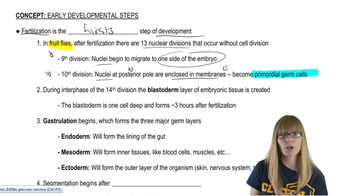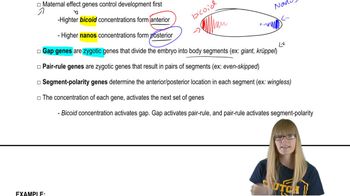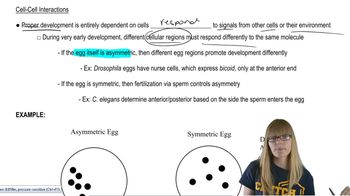Table of contents
- 1. Introduction to Genetics51m
- 2. Mendel's Laws of Inheritance3h 37m
- 3. Extensions to Mendelian Inheritance2h 41m
- 4. Genetic Mapping and Linkage2h 28m
- 5. Genetics of Bacteria and Viruses1h 21m
- 6. Chromosomal Variation1h 48m
- 7. DNA and Chromosome Structure56m
- 8. DNA Replication1h 10m
- 9. Mitosis and Meiosis1h 34m
- 10. Transcription1h 0m
- 11. Translation58m
- 12. Gene Regulation in Prokaryotes1h 19m
- 13. Gene Regulation in Eukaryotes44m
- 14. Genetic Control of Development44m
- 15. Genomes and Genomics1h 50m
- 16. Transposable Elements47m
- 17. Mutation, Repair, and Recombination1h 6m
- 18. Molecular Genetic Tools19m
- 19. Cancer Genetics29m
- 20. Quantitative Genetics1h 26m
- 21. Population Genetics50m
- 22. Evolutionary Genetics29m
14. Genetic Control of Development
Early Developmental Steps
Problem 6
Textbook Question
What is the difference between a parasegment and a segment in Drosophila development? Why do developmental biologists think of parasegments as the subdivisions that are produced during development of flies?
 Verified step by step guidance
Verified step by step guidance1
Understand that in Drosophila development, the embryo is divided into repeating units called segments and parasegments.
Recognize that segments are the visible divisions on the larval cuticle, while parasegments are defined by the expression of specific genes during early embryogenesis.
Note that parasegments are offset from segments by half a segment, meaning that each parasegment includes the posterior part of one segment and the anterior part of the next.
Consider that developmental biologists focus on parasegments because they are the primary units of gene expression and patterning during early development, which later give rise to the segments.
Acknowledge that the concept of parasegments helps in understanding the genetic and molecular mechanisms that control the development and patterning of the Drosophila embryo.
Recommended similar problem, with video answer:
 Verified Solution
Verified SolutionThis video solution was recommended by our tutors as helpful for the problem above
Video duration:
3mPlay a video:
Was this helpful?
Key Concepts
Here are the essential concepts you must grasp in order to answer the question correctly.
Segments in Drosophila Development
Segments are the primary body divisions in Drosophila, established during early embryonic development. Each segment corresponds to a specific region of the adult fly, contributing to the overall body plan. Segmentation is crucial for the proper organization of tissues and organs, and it is regulated by a series of genes that dictate segment identity.
Recommended video:
Guided course

Drosophilia Development
Parasegments in Drosophila Development
Parasegments are developmental units that are offset from the segments, consisting of parts of two adjacent segments. They play a key role in the organization of the embryonic body plan, as they are involved in the positioning of structures and the expression of specific genes. Parasegments help in understanding how segments are formed and how they interact during development.
Recommended video:
Guided course

Drosophilia Development
Developmental Biology and Gene Regulation
Developmental biology studies how organisms grow and develop, focusing on the genetic and molecular mechanisms that guide these processes. In Drosophila, specific genes, such as segmentation genes and homeotic genes, regulate the formation of segments and parasegments. Understanding these regulatory networks is essential for comprehending how complex body structures arise from simple embryonic patterns.
Recommended video:
Guided course

Segmentation Genes

 3:46m
3:46mWatch next
Master Drosophilia Development with a bite sized video explanation from Kylia Goodner
Start learningRelated Videos
Related Practice


